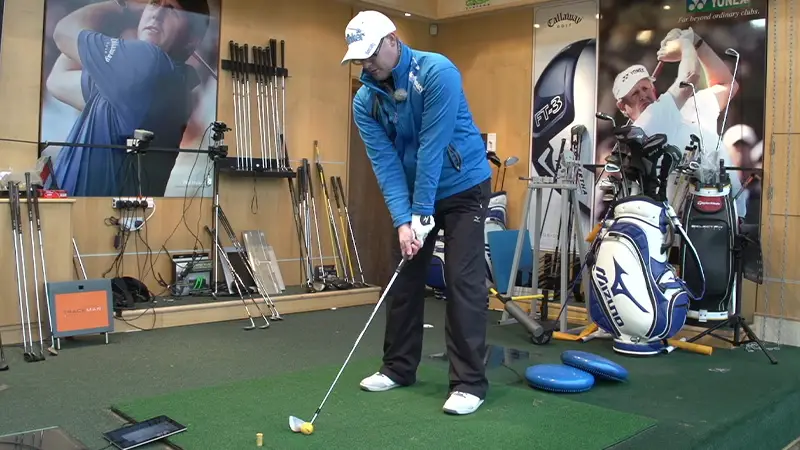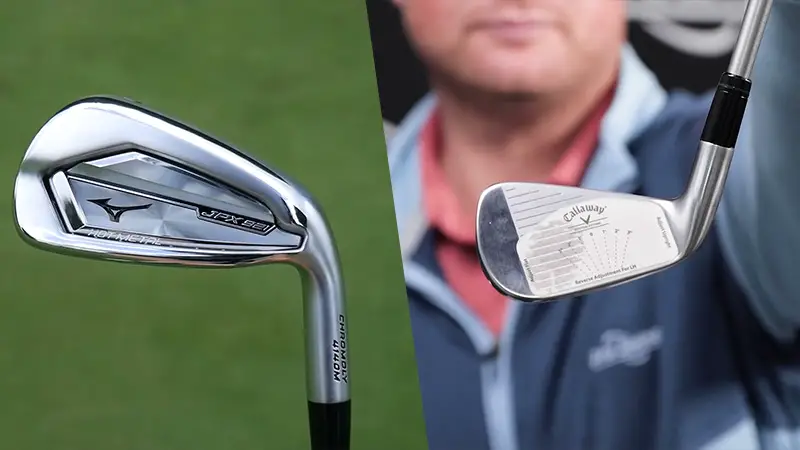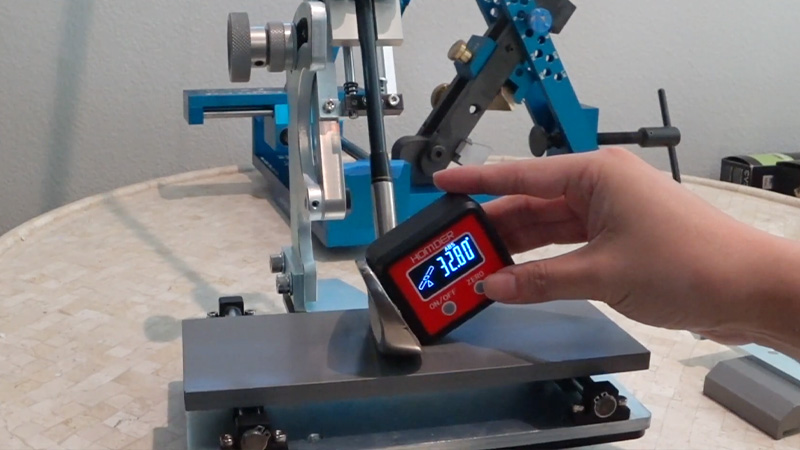Measuring loft on a golf club is a fundamental skill in club fitting, enabling players to optimize their shots. Loft, the angle between the clubface and shaft, profoundly impacts the ball trajectory.
This guide outlines precise steps for accurate loft measurement, enhancing understanding of club performance.
Proper loft assessment empowers golfers to tailor their equipment to varying course conditions and playing styles.
By mastering this technique, players can make informed decisions about club selection, adjustability, and overall game improvement.
Whether you’re a seasoned golfer or a novice, learning to measure loft ensures a more strategic and effective approach to each swing.

How to Measure Loft on a Golf Club?
Measuring the loft on a golf club is a crucial aspect of club fitting and customization, as it directly affects the trajectory and distance of your shots. Loft refers to the angle of the clubface in relation to the vertical plane.
Clubs with higher loft angles produce higher shots with more backspin, while clubs with lower loft angles generate lower, more penetrating shots.
Tools Required
- Golf Club
- Loft and Lie Angle Gauge
- Ruler or Protractor
- Sharpie or similar marker.
To accurately measure the loft on a golf club, follow these steps:
Gather the Necessary Tools
Before you begin measuring the loft on a golf club, make sure you have the appropriate tools at hand. The loft and lie angle measuring tool is essential for this task.
This tool is specifically designed to provide accurate measurements of loft and lie angles. Additionally, have a marker or tape ready to mark the center of the clubface.
Prepare the Club
Choose a stable surface or a club holder to securely position the golf club. It’s important to have the clubface pointing upwards and accessible for measurement.
Mark the Clubface
Using a marker or tape, create a clear and visible mark at the exact center of the clubface. This mark will serve as a reference point when aligning the loft and lie angle measuring tool.
Position the Measuring Tool
Take the loft and lie angle measuring tool and place it carefully on the clubface. The tool typically has two arms, with one arm meant to sit on the clubface and the other extending along the shaft.
Align the tool in a way that the arm resting on the clubface is directly over the center mark you made earlier.
Read the Loft Angle
Direct your attention to where the arm extending along the shaft intersects with the main body of the measuring tool. This point will display the loft angle of the clubface.
The measurement is usually given in degrees, representing the angle between the clubface and the vertical plane.
Repeat for Accuracy
To ensure precise measurements, it’s recommended to take multiple readings of the loft angle.
Gently reposition the measuring tool and verify that each reading is consistent with the others.
If there are slight variations, calculate the average of the measurements to get a more accurate value.
Consider Lie Angle
While you’re measuring loft, you might also want to evaluate the lie angle of the club. The lie angle influences how the club sits on the ground at impact.
A proper lie angle ensures that the sole of the club makes optimal contact with the turf, contributing to better shots.
Professional Guidance
For the best results and personalized adjustments, consider consulting a professional club fitter.
These experts have the necessary tools and knowledge to fine-tune your club’s loft and other specifications according to your swing characteristics and playing preferences.
Their expertise can lead to improved performance and a more enjoyable golfing experience.
Difference Between Loft and Lie

Loft and lie are two important concepts in golf club design that have a significant impact on how the ball behaves when struck.
Here’s a detailed explanation of the differences between loft and lie:
Definition
Loft: Loft refers to the angle of the clubface relative to the shaft. It determines the initial launch angle and trajectory of the golf ball.
Lie: Lie refers to the angle formed between the shaft and the ground when the sole of the clubhead is flat on the ground. It influences the direction the ball travels in relation to the target line.
Measurement
Loft : Loftis measured in degrees. It is the angle formed between a vertical line (perpendicular to the ground) and the face of the clubhead.
Lie: Lie is measured in degrees. It is the angle formed between the shaft and a line that’s perpendicular to the ground.
Impact on Shots
Loft: Higher loft angles result in higher ball trajectories and shorter distances. Clubs with higher loft, such as wedges, are used for shots that need to carry over obstacles or stop quickly on the green. Lower loft angles produce lower trajectories and longer distances, which are typical of drivers and fairway woods.
Lie: Incorrect lie angles can lead to shots that veer to the left (for right-handed golfers) or to the right (for left-handed golfers). Proper lie angles ensure that the clubhead’s sole makes solid contact with the ground at impact, promoting accurate and consistent shots.
Variation Across Clubs
Loft: Different clubs have varying degrees of loft. For instance, drivers typically have lower loft angles (around 8 to 12 degrees), while wedges have higher loft angles (up to 60 degrees or more).
Lie: Lie angle is primarily a consideration for irons, as the lie angle is influenced by the length of the shaft and the golfer’s stance at address. It has a more subtle impact on woods and drivers.
Adjustability
Loft :Some clubs, especially drivers and fairway woods, have adjustable hosel mechanisms that allow players to tweak the loft angle to fine-tune ball flight.
Lie: Lie angles can be adjusted by bending the hosel of the club. Clubs that are too upright (toe pointing up) tend to produce shots that go to the left (for right-handed golfers), while clubs that are too flat (heel pointing up) tend to produce shots that go to the right.
Alternative Methods for Measuring Loft
Measuring the loft of a golf club accurately is essential for understanding your equipment’s performance. While using a loft and lie angle gauge is the most precise method, there are a few alternative techniques you can try:
Shadow Method
On a sunny day, stand the club upright with the shaft perpendicular to the ground. Position yourself so that the club’s shadow falls directly beneath it.
The angle formed between the clubface and the ground is approximately the loft angle. However, this method might not be as accurate as using specialized tools.
Impact Tape or Spray
Apply impact tape or impact spray to the clubface and hit a ball or a foam ball against a net or a safe area.
Examine the pattern left on the tape or the spray, paying attention to where the ball struck the face.
This can give you a visual cue about the club’s impact pattern, which relates to its loft.
Compare to Known Club
If you have a club with a known loft angle (e.g., a pitching wedge), you can place the clubfaces of the two clubs together on a flat surface. Align the leading edges and compare the angles between the shafts. This can provide a rough estimation of the loft difference between the clubs.
Tips for Accurate Loft Measurement

Accurately measuring the loft of your golf clubs is essential for proper club fitting and optimizing your performance on the course.
Here are some tips to ensure precise loft measurements:
Use a Quality Loft Gauges
Invest in a reliable loft and lie angle gauge. A quality gauge ensures consistent and accurate measurements. Cheaper or poorly calibrated gauges can lead to inaccurate readings, affecting your club fitting decisions.
Set Up on a Flat Surface
Place the loft and lie angle gauge on a level surface. Even a slight tilt can influence the measurement, so ensure the gauge is stable and properly aligned before starting the measurement process.
Secure Club Placement
When placing the clubhead on the gauge, make sure it rests squarely against the loft angle measurement arm. The clubface should be perpendicular to the ground, and the shaft should be parallel to the surface.
Center the Clubface
Ensure the clubface is centered on the measurement arm to prevent any skewing of the reading. Even a small misalignment can result in inaccurate loft measurements.
Check for Proper Contact
Confirm that only the sole of the clubhead makes contact with the measurement arm. The rest of the club should not touch the gauge, as this could affect the angle of measurement.
Double-Check Alignment
Before recording the measurement, double-check that the clubface is still properly aligned with the gauge. Any movement during this step can introduce errors into your loft measurement.
Professional Assistance
If you’re uncertain about the accuracy of your measurements or if you’re looking for precise adjustments, consider seeking help from a professional club fitter. They have the expertise and tools to ensure your clubs are perfectly customized for your game.
Document Measurements
Maintain a record of the loft measurements for each of your clubs. This record can be invaluable when discussing club fitting options with professionals or when making decisions about adjustments in the future.
Be Mindful of Adjustable Clubs
For clubs with adjustable hosel mechanisms, ensure that the loft is set to the desired angle before measuring. Changes to the hosel can significantly alter the loft, so the club must be properly adjusted before measurement.
FAQs
What is loft on a golf club?
Loft refers to the angle between the clubface and the shaft of a golf club. It plays a significant role in determining the initial trajectory and height of the ball when struck.
Why is measuring loft important?
Measuring loft helps golfers understand their club’s performance and tailor their shots to different situations. It guides club selection and customization for optimal distance and accuracy.
What is a loft and lie angle gauge?
A loft and lie angle gauge is a specialized tool used to measure both the loft and lie angles of a golf club. It ensures accurate measurements for club fitting and adjustments.
Can I use alternative methods to measure loft?
Yes, alternatives like impact tape, reference charts, or comparing to known clubs can provide estimates of loft.
How does loft affect my shots?
Higher loft angles create higher ball trajectories and shorter distances, while lower loft angles produce flatter trajectories and longer distances.
To Wrap Up
Measuring loft on a golf club is a skill that merges precision with understanding, offering a deeper connection to your game.
Whether using a dedicated loft gauge, alternative methods, or seeking professional assistance, this process enhances your grasp of club dynamics.
Accurate loft measurements empower club customization, aiding in selecting the right clubs for specific shots and course conditions.
Embracing this knowledge equips you to fine-tune your equipment, adjusting for optimal trajectories and distances.
As loft shapes your shots, mastering its measurement becomes a pathway to unlocking the full potential of your golfing prowess, leading to better decision-making on the course and improved overall performance.
Leave a Reply